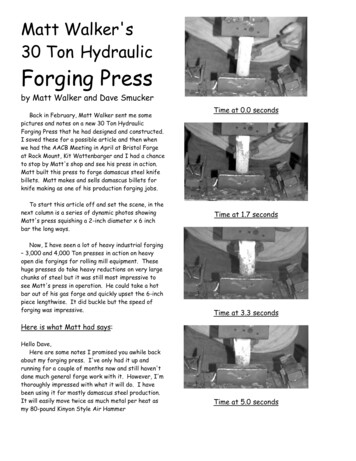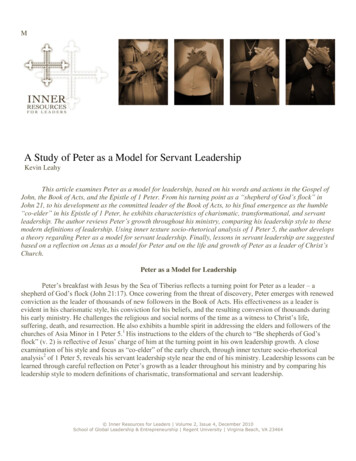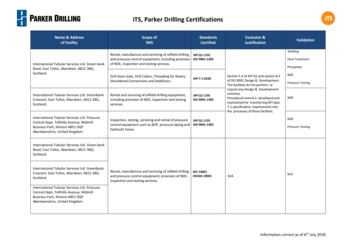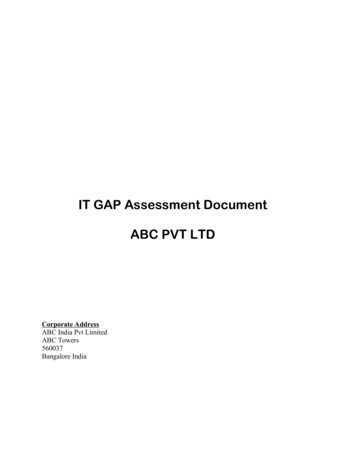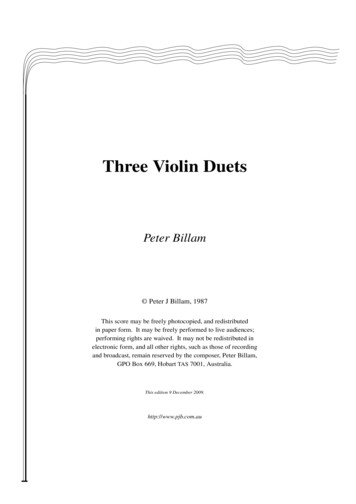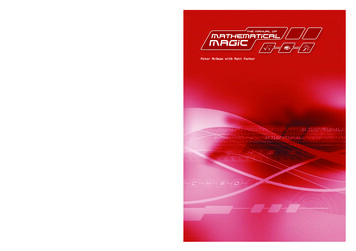
Transcription
of MathematicalMagicThe ManualManual ofMathematical l No.No.No. 108910891089ParkerMcOwan andand isbookbookbookarearearecopyrightcopyrightcopyright rmission.permission.reproducePeterPeterPeter McOwanMcOwanMcOwan withwithwith MattMattMatt ParkerParkerParker
isThis isis youryour nygraphics.comISBNISBN No.No. 978-0-9551179-7-8978-0-9551179-7-8109064 Inner Coverspread.indd109064 Inner Coverspread.indd 1107/01/201007/01/2010 17:1317:13
The Manual of Mathematical MagicMathematics and magic may seem a strange combination, butmany of the most powerful magical effects performed today havea mathematical basis. Famous magicians such as Derren Brownand David Blaine use mathematics-based tricks in their shows, butmathematics is also the secret behind the technologies we use, theproducts we buy and the jobs we will have. Mathematics is thelanguage we use to describe the world around us - it’s the basis of allthe sciences.This book will show you how to perform some magical miraclesto impress and entertain your friends. But it will also explain themathematics behind the tricks and how that same mathematics is usedin the real world. It also looks at the varied and exciting sorts of jobsthat make use of the mathematics powering your magic.All the tricks in this book are self-working, which means you don’tneed to know any clever sleight of hand, like dealing cards from thebottom of a deck. But be warned: knowing the mathematical secretisn’t the same as being able to perform the tricks well. To do that, youneed to use your performance skills to create a sense of wonder. Agood presentation is where your audience is pulled into the magichappening and astonishment happens. With an imaginative story, youcan take a simple mathematical trick and turn it into a jaw-dropper.This book will give you some ideas for presentations, but be creative,come up with your own way. Thinking creatively about new ways tosolve problems is the key to good magic but it’s also one of the keyskills of a good mathematician and one of the useful employment skillsyou get from being good at mathematics. As we will see, many famousmathematicians were also magicians.It’s not a coincidence - theyenjoyed their maths, and also enjoyed using it to entertain. And nowyou can too.As you start to work your way though this book, you will find magicthat uses a whole range of mathematical ideas that you may alreadyhave come across, from simple addition and subtraction, to primenumbers, geometry, algebra and statistics. We hope that this bookshows that all of maths can be exciting, magical and useful. There iseven an advanced section where some maths that’s probably new toyou is introduced, with stunning magic results. So have some seriousfun, learn, practice, create and above all entertain.
Some of these tricks are in the acts of professional magicians.So when you do perform them, please remember theMagicians Code: practise, practise, practise. And never revealthe workings of magic tricks to your audience!The SymbolsThroughout this book you will see four different symbols. Each one is used toexplain a different aspect of a trick.The magic symbol is how the trick will actually look to youraudience. This will explain how the trick should flow and will giveyou an overview of how it should come across to observers. Thiswon’t tell you the sneaky things that you need to be doing!This is where the sneakiness is explained. The presentationsymbol is where the actual trick itself is explained. This will gostep-by-step through what you need to do to make sure the trickworks and how you can increase the effect on your audience.Don’t forget that the best magic tricks use a very simple devicebut then this is built up through a brilliant presentation. Once yougrasp how the trick works, be sure to try expanding on your ownpresentation ideas!All of the tricks in the book are based on mathematicalprinciples. Normally this is explained in the presentation section,but when the maths is particularly important, or you need tolearn some extra maths to make the trick work, you will see this,the maths symbol.Some of the best tricks that are based on maths are all aroundus every day, from our computers to the food we eat. Wheneverthe maths that is used in a trick has some particularly interestingapplications to the real world or to different professions, you willsee the applications symbol and a brief explanation. You canalways do some more research into any of these applicationsand you will definitely find many more than we had room tomention.So on with the magic. Are you watching closely?
ContentsThe Magic of Basic MathematicsAddition – It All Adds Up To A False CutAddition and Subtraction - The Dented Card TrickAddition and Subtraction – The Force of NatureMultiplication – Showing Double Digit DexterityMultiplication and Addition – Doing Fibonacci’s Lightning CalculationDivision - The Fast Five TrickFactorising - The Calculator Beating TrickAddition, Subtraction and Psychology - The Teleporting CardEven and Odd Numbers – The Piano TrickBasic Mathematics- The ApplicationsBinary Numbers- The Super Memory ExperimentBinary Numbers - The ApplicationsTernary Numbers - The Card at any Number TrickAlgebra - The Brain Control ExperimentAlgebra – The Number of Matches PredictionAlgebra and Addition – The Amazing CoincidenceAlgebra -The ApplicationsPrime Numbers – Twice the Impossible LocationPrime Numbers- The ApplicationsGeometry – The Find a Card by Psychic Aura TrickGeometry - The ApplicationsStatistics- Quick Think of a Number, The Street Magic StuntStatistics - The ApplicationsAdvanced Magic and MathematicsClock Arithmetic – The Fairest Test (ever) of Psychic SkillsClock Arithmetic – Professional Deck StackingModular arithmetic- The ApplicationsFinal 62667678Bonus Effects – The Maths Hustle (or How to Win with Maths)Bonus Hustle Effect 1- The Glass ChallengeBonus Hustle Effect 2 - The Napkin GameGlossary of useful terms80818384
“Inventing a magic trick andinventing a theorem are verysimilar activities.”Mathematician and magicianProfessor Persi Diaconi
The Magic of Basic MathematicsLet’s start with the easy stuff. Maths is about manipulating numbers andlooking for patterns in those numbers. Adding, subtracting, multiplying anddividing are the building blocks of basic maths. We need these skills everyday, just like reading and writing. This first section shows that even these simplemathematical steps can be magical with the proper presentation.1
AdditionIt All Adds Up To A False CutFor many of these tricks, you will need to have certain cards in certainplaces in the deck for them to work. Magicians call this positioning ofcards in a deck stacking the deck. But, as your audience might suspectyou’ve been up to something sneaky before the trick starts, that’s wherefalse shuffles and cuts come into play. It looks like you are fairly mixingthe deck while in fact you do no such thing and the cards are in the sameorder at the end as they were at the beginning. Here’s one of the simplestfalse cuts. It looks like a real gamblers cut but doesn’t change the orderof cards in the deck at all.Put your pack on the table. Let’s call this pile A. Now cut off about thetop third from this pile and place these cards to the right. Let’s call thispile B. Now cut half of what’s left in pile A and place this further to theright of pile B. We’ll call this pile C.All that remains is for you to pause, then reassemble the pack. Place pileB onto pile C, then take this combined pile and place it on the cards inpile A.To the audience this looks like a fair series of cuts, but if you try it with apack you will discover that the pack is in exactly the same order at theend as it was in the beginning.2134pile A2pile Bpile C
Why? Well, all this false cut does is show that when you first cut the cardsinto piles, you put the top third in pile B, the middle third in pile C andleave the bottom third in pile A. So, going from left to right, your pack iscut into three piles A (bottom), B (top) and C (middle). When you gatherthem back together, you put B on top, then C in the middle and then A atthe bottom – exactly where they came from!It’s obvious that the order of the cards stays the same, it is just simplearithmetic, but done in an offhand, casual way while telling the audienceyou really are mixing the cards they will believe you. It is enough toconfuse the onlookers, and a useful way to start your tricks too.It looks like a real gambler’s cutbut doesn’t change the order ofcards in the deck at all.3
Addition and SubtractionThe Dented Card TrickYou demonstrate that your ‘super sensitive fingertips’ can find the dentin a chosen card which has been tapped by a spectator, even when ithappens with your back turned.First your spectator shuffles the deck. No funny business - it can evenbe their own battered deck. Then you ask them to choose any numberbetween 1 and 10. You turn your back and tell them to count off the topcards, one by one, until they reach their secret chosen number and thentap and remember the card at that number. They must leave it where it is.With your back still turned they then replace the cards and give the deckto you. You dramatically turn to face them, explaining that you will shufflethe cards then try and read them with your sensitive fingertips. You willthen move their card to a different position in the deck.Meanwhile, you have casually put your hands behind your back. As youare talking, your hands are doing some secret counting. Rapidly count offexactly 19 cards and as you do, reverse their order, then replace themon the top of the deck. Announce that you have been successful! Youfound their ‘dented’ card and have moved it to the twentieth position inthe deck.Bringing the pack into view ask your spectator what number they thoughtof. Suppose they tell you it was 7. You start to count cards out loud fromthe top of the deck beginning, “8, 9, 10 ” and so on ‘feeling’ eachone as you go. When the count reaches 20, pause. What card did they‘dent’? They name the card. You turn over the twentieth card and it’stheirs!4
So how does it work? Your spectator chooses a number between 1and 10, let’s call it X. Their card starts out in position X. Behind yourback, you reverse count off the top 19 cards so the card that wasat X from the top is now at position 19-X 1. (To see why we add1, imagine they chose X 1. After the reverse count off, the chosencard is the top card. It doesn’t move to position 19-1 18, it moves toposition 19. We have to add an extra 1 as we begin counting at 1rather than 0. So their card is now at position 20-X.)In the example where your spectator chose X 7, after yourhidden reverse count, the card is now at position 20-7 13. Yourfinal countdown actually counts off 20-X cards, starting at 7 (thespectator’s X). Mathematically, this is written (20-X) X and of coursethis is 20. So their card will always end up at position 20 no matterwhat number they originally chose!
Addition and SubtractionThe Force of NatureWhile your spectator thinks they are completely in control, youare able to force them to select a card of your choosing. You canthen reveal the value of this card in any clever way suitable. Forexample, you could have texted or emailed it to them earlier. Getthem to read the message now.Seemingly allowing the spectator a free choice but actuallyensuring the card you know is selected, is a basic magician’s tooland the basis of many a good trick. It’s called a force. There areloads of ways to do it but here is a simple mathematical way.For the first force, secretly put the cardyou want selected on the top of the deck.Ask your spectator to tell you a numberbetween 1 and 10. Explain to them thattheir choice was free and that you wantthem to count down one card at a time totheir chosen number.Before they do this and to help thingsalong, you demonstrate what they need todo and count down that number of cardsone at a time onto the table, so reversingtheir order.You then scoop up the cards from the table,pop them back on top of the deck andpass the complete deck to the spectator.Get them to do the counting and theirfreely chosen card is, exactly the one youknew it to be.
This works because of simple addition and subtraction. Say theychoose 4. Your example deal of four cards onto the table putsyour force card (previously on top of the deck) at the bottomof the tabled pile. Putting this tabled pile back on the deck andletting the spectator deal again reverses that, so the 4th carddown now becomes the top card on the pile on the table.The two deals cancel each other exactly. Done casually, thespectator won’t remember that you helpfully counted the cardsout the first time so don’t remind them.Leaving a period of time between your first demonstration dealand their later actual deal is called time misdirection. Speak tothem during this stage. Ask questions: why did you choose 4?Has that some special significance? And so on, to help them to‘forget’ your casual useful demonstration. You can even throwin a false cut after you did the first deal to remind them they arecounting out using a ‘shuffled’ deck and consequently to makeyour powers seem even more amazing.Clearly, to make this work, you need to know the number theyselected. So in the presentations, make sure you say somethinglike, “Give me any number ” rather than, “Think of a number ”,unless, of course, you can mind read! You could also start tocount down from 10 to 1 and ask them to stop you at anynumber, or ask them to write a number on the board. Getcreative. But get that number!7
MultiplicationShowing Double Digit DexterityMost people can do a speedy multiply by 10. You just add a zero to theend of the number – 23 multiplied by 10 is 230, simple. Now you canprove your superior mental superpowers by speedy multiplication of anytwo-digit number by 11. You explain to the audience that this is clearlyfar more difficult. They have the calculators on their mobile phones readyto check, but you do your calculations correctly before they even start toclick the keys.Imagining the 11 times trickTo give us this superpower, we make use of two things. One is maths andthe other is the human brain’s power of imagination.To do a lightning calculation multiplying any two-digit number by 11, youneed to use some visual imagery and use your imagination. Let’s take thenumber 2 for example. Now imagine a space between the two digits,so in your minds eye you imagine 2. Add the two numbers togetherand imagine putting the sum of them in the gap in the middle, so you see ( 2) 2. And that is it, you have the answer: 11x 2 (7) 2 72.The double trouble trickBut what if the numbers in the gap add up to a double digit? Forexample, suppose you want to multiply 98 by 11. So, you imagine 9(9 8) 8. But that bit in gap in the middle gives you 9 8 17, so where doyou put these digits? 9 (17) 8?Easy, just leave the second number (here the 7) in the gap as before andimagine moving the 1 up a place, so you have(9 1) 7 9 10 7 9 1079. Correct again.8
The maths behind this is fairly easy if you explore it. Suppose you havethe number AB (that’s A tens and B ones) and you want to multiply by11. First you multiply by 10. That’s easy, 10xAB AB0 (A hundreds, Btens and 0 ones). Then you add another AB so you’ve got 11 lots of ABaltogether, giving you A hundreds, (B A) tens and (0 B) ones.This is exactly what all that sliding numbers around in your imaginationhas been doing without knowing it. Of course, if the middle A B is morethan 10 (ie it’s a double digit number), you just slide the first digit up tothe hundreds column, and it’s sorted.Lightning calculations by mind power and a maths trick. Mathematiciansmake use of their imaginations all the time. Our brains are really good atimagining things and creating pictures in our heads. Often that’s the waywe solve tricky problems or come up with clever visual imagination trickslike this one.9
Multiplication and AdditionDoing Fibonacci’s Lightning CalculationOn a piece of paper, write the numbers 1 to 10 in a column. You are now allset to amaze with the speed at which you can add ten numbers.Ask your friend to choose any two two-digit numbers and write the numbersdown in the first two spaces of your column, one under the other. Your friendthen makes a third number by adding these first two numbers together andwrites it below the first two, in effect starting a chain of numbers. They makea fourth number by adding the second and third, a fifth by adding the thirdand fourth, and so on, until your column of ten numbers is full.To show how brilliant you are, you can turn away once your friend hasunderstood the idea, say after the seventh number in the list. Now you can’teven see the numbers being written.Meanwhile, with your back turned, you are actually multiplying that seventhnumber by 11 to get the final answer.Let’s imagine your friend chose 1 and 21 to start with. The list would looklike this:1.2.3.4. . .7.8.9.10.16213758951532484016491050You now turn round and write the sum of all ten numbers straight away!Lightning quick, you say it is 2728. Let them do it slowly on a calculator toshow your brilliant mind skills are 100 per cent correct.The final answer just involves multiplying the seventh number by 11. Why?10
Well this chain of numbers where the next term is made by adding theprevious two terms is called a Fibonacci sequence. Fibonacci sequenceshave special mathematical properties that most folk don’t know about So let’s look at the trick. We start with the two numbers A and B. The nextnumber is A B, the next number is B added to A B which is A 2B andso on. Going through the number chain we find:1.2.3.4. . .7.8.9.10.ABA BB (A B) A 2B(A B) (A 2B) 2A 3B(A 2B) (2A 3B) 3A 5B(2A 3B) (3A 5B) 5A 8B(3A 5B) (5A 8B) 8A 13B(5A 8B) (8A 13B) 13A 21B(8A 13B) (13A 21B) 21A 34BAdding up all 10 numbers in the chain gives us a grand total of55A 88B – check it yourself. But look at the seventh number in yourcolumn this line is 5A 8B. It is exactly the total of the chain but dividedby 11!So working backwards, you can get the final total by multiplying theseventh term by 11. And the maths proves this lightning calculation willwork for any two starting values A and B.It is up to you to present this trick in such a way that it looks like you arejust very, very clever. Which of course you are, as you now know how touse a Fibonacci sequence for magic.11
DivisionThe Fast Five TrickLook all around, fives are everywhere. Five fingers, five toes. Now thinkabout division. Divide by 10? Easy you say – just move the decimal pointone place to the left. But by ? Far more of a challenge! Now you canimpress you friends with your ability to divide any number by at superspeed - and do the calculation correct to three decimal places!Not a lot of people know this, but dividing a large number by canactually be done by a very simple two-step method.Step [1]: multiply the number by 2.Step [2]: move the decimal point.That’s all there is to it.Now you can impress youfriends with your ability todivide any number by atsuper speed.Of course, your claim to do the calculation correct to ‘three decimalplaces’ is just presentation to make it sound more impressive. It’s reallyeasy. All you do is get the answer, say 23.7, and add two zeros after the7 to give 23.700. So that’s the answer right to three decimal places asyou promised. Our maths proof below will actually show us that we willonly ever get an answer with one decimal place. The rest is just magicalflim-flam!12
It is always a good idea to start easy with a simple example to test ourmethod works so let’s look at 10 divided by . First, our method says wedouble the number, so doubling 10 we get 20. Then we shift the decimalpoint, so 20 now becomes 2.0 or 2. The answer’s correct. Good start.Now for a harder example, say 190 divided by . This looks toughwithout a calculator, but following our method, step [1], double 190 toget 380, and step [2], move the decimal point, so 380 becomes 38.0 orjust plain old 38.Harder still: how about 4 7 divided by . Again, step [1], double thenumber, so we have 4 7 x 2 9134. Then step [2], shift the decimalpoint to get 913.4. It’s correct - check with a calculator if you don’tbelieve it.And lets get silly: 1234 789 divided by . Step [1], double it, so2 x 1234 789 24 913 78. Step [2], shift the decimal point andthe answer is 24 913 7.8. (You may really want to check this on acalculator!)Will it always work?Could there be a number somewhere that you haven’t tested and that thetrick doesn’t work for? That would be embarrassing so let’s look at themaths. That way, we can be sure as we can prove it will always work andsave red faces all round.Dividing by five is like doing half of a divide by 10. Dividing by 10 iseasy, you just shift the numbers down a ‘slot’, so 100 divided by 10 is10.0, 23 divided by 10 is 2.3 and so on.Well, division has a rather neat trick or mathematical property of its own.As you know, fractions are just another way of writing divisions. So 100divided by 10 can be written as 100/10 and 23 divided by 10 can bewritten as 23/10 .13
DivisionThe Fast Five TrickAnd if you do the same thing to the top of a fraction as you do to thebottom, the answer to your division (or the ratio of the top to the bottom)remains the same.So multiplying the top and bottom by 2 each time, we have8/4 4/2 1 /8 2. The result is always the same.Taking any number A and dividing by means that A/ is exactly the sameas (2xA)/10 . Here we have just multiplied top and bottom by 2.And there we have it - that simple formula proves the maths. To divideANY number A by , first double it, step [1] and then shift the decimalplace, that is divide by 10, step [2]. We can see it will always work.What we have done here is what mathematicians and computer scientistsdo all the time - no, not divide by ! They to come up with a series ofsteps (which we call an algorithm) and then try to show mathematicallythat it will always do what is supposed to.A ChallengeTry a bit of maths yourself. Here is a twostep algorithm to multiply a number by :Step [1]: divide by 2.Step [2]: move the decimal point to theright.Can you work out if this will method willalways work?14
1
FactorisingThe Calculator Beating TrickYou start by asking for a random four-digit number from anyone in theaudience. You write it up on a board. Now, you explain, in a momentthe next volunteer will give you a second four digit number and you willmultiply them in your head faster than anyone else can, even if they areusing a calculator.But wait! If they already know the next number, they can start thecalculation early! To make it fair, as soon as they say the second number,you will also pick a new four-digit number and multiply the firstnumber by it.To make it even harder, you will perform both multiplications and thenadd the answers together, to get the total faster than anyone with acalculator. And sure enough, you do!Make a big deal of the fact that you will be multiplying two randomfour-digit numbers faster than a calculator. Then play down everythingelse that you add to the calculation, make it look like an after-thought.Afterwards, people will only remember that you multiplied togetherrandom numbers given by the audience.Begin by writing the first number from the audience on the board.Indicate below where the next number will go, write up a multiplicationsign next to it and show where you will write the answer. Then, to theright, write the first number again, with a new multiplication sign andindicate where you will put your random number and then that answer.Where the two answers go should line up so you can put an additionsign between them and an equals sign below.1
As soon as the volunteer gives you the second number, write it in its placeand then write your number in its place.The trick here is to choose your number so that each digit is the ninecomplement to the corresponding digit in their number. This means chosethe digits that, when added to the digits in their number, give a total ofnine each time.So if their number starts with a 1, you would start your number with an8 because 1 8 9. Then continue this for all the digits. So if they said170 , you would choose 8294 for your number.Then you skip the multiplication answers and go straight to writing thegrand total at the bottom.Let’s say that the very first number that your volunteer suggested was 791. Write this number in the final answer position, but subtract 1 fromit, so in this case it would be 790. Quickly follow this with the fourdigits that would be its nine complement, so here you would write 4209.The answer will always be eight digits long, so write the first four with aspace like this: 7 90 and then seamlessly complete it as 7 904 209. Itlooks more impressive - and hides where the number came from - if youwrite it with the spaces in the correct places. Then all you have to do iswait for the people with calculators to catch up and confirm that you arecorrect!17
FactorisingThe Calculator Beating TrickLet’s say that the very first number that you wrote on the board was A.Then you are going to get a second number from the audience that we’llcall B and you get to choose the third number C. The calculation youperform will be multiplying A by B and then adding it to A multiplied byC. We can write this as A.B A.C .As you can see, A is a common factor, so we can simplify the calculationby factorising it out like this: A.(B C). The audience gets to choose Bbut this doesn’t matter as you can pick C to make the total B C to be areally easy number to multiply by.Now, you could choose C so that A B 10 000 and then write theanswer as A followed by four zeros. But everyone in the audience willimmediately spot how you got the answer and they won’t be the least bitamazed.To hide the trick, we choose C so that B C 9999 (which is why C isthe nine complement of B). Then the grand total of A x 9999 is one lessthan A followed by its nine complement. Try a few different numbers tomake sure you are happy with how it works.With a bit of practice, you’ll be able to write out nine complement fasterthan people can even type numbers into a calculator! But be careful toonly perform it once in a show, otherwise the audience might start to spotthe patterns.This trick actually works with numbers of anylength, as long as they all have the samenumber of digits. But only using three digitslooks too easy and for numbers of five or moredigits, it becomes increasingly obvious that thefirst number appears at the start of the answer.18
19
Addition, Subtraction and PsychologyThe Teleporting CardTeleporting is a staple of magic. First something is here, then it’smagically there. In your demonstration you count out exactly 10 cards.You place five of them on one side of the room and the remaining five onthe other. Then, invisibly, one card travels from the first pile to the second.Have you really mastered powers of teleporting, or is it all in the mindof your spectators? Here’s how this cunning bit of mind manipulation ispossible.This trick uses really simple mathematics and a bit of a psychologicalbrain trick. Start with an ordinary pack of playing cards. In stage oneyou are going to do what magicians call the convincer.You count out ten cards face down, but you do it in reverse. First carddown, count 10. Next card is 9. Count out loud and clear: 8, 7, 6, 5,4, 3, 2, 1. When you put the cards down, spread them slightly so thespectators can see it’s a fair count of 10 cards. Convince them - it’s true,there are 10 cards on the table. Your spectators are now primed tobelieve that reverse counting is an accurate way to count cards. Pick upthese ten cards, and put the rest of the pack aside.An action repeated that lookslike the previous action istreated much the same.Now comes the sleight of mind. Like a sleight of hand where magiciansmove cards in a sneaky way to fool their audience, you’re going to foolthe spectators’ brains. You tell them that you’re going to deal the tencards into two piles of five, but again you’re preparing them for what’s tocome.20
Into one pile you count from 10 down to 5, this time notspreading the cards in the pile. That’s half the ca
The Magic of Basic Mathematics Let’s start with the easy stuff. Maths is about manipulating numbers and looking for patterns in those numbers. Adding, subtracting, multiplying and dividing are the building blocks of basic maths. We need these skills every day, just like reading and
